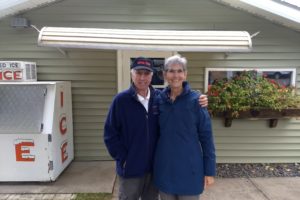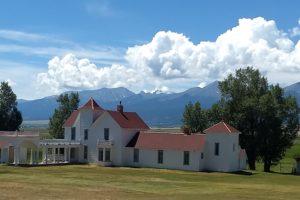Most of our time on this trip to Colonial Williamsburg was spent in the Palace Green area since we had missed so much in this area on our other visit. Staff in costume were walking around and were available for conversations. I stopped this young woman because I noticed that the length of her skirt was shorter than the skirts of other women I had seen. Since puddles were everywhere from a recent rain, I thought this length was prudent.

Bruton Parish Church – Walk Where Founders Worshiped

“This three-centuries-old Episcopal church has hosted many famous patriots. At the time of the Revolution the Church of England was the official church, and all Virginians were expected to attend regularly.” (info from website)
Monthly fees were required for members (everyone in the city), even if they didn’t attend. But at least some of these fees were spent well since the church was responsible for the care of those in need.

We were interested in the pews since many were in a box shape and all had doors that closed off the seating area. We learned that the thought of the day was that parishioners didn’t need to be looking forward to see the service since it was more important to hear the truth of scripture than to see the church leadership.
Today some of the boxes have a pew that’s been turned around to face forward.

pew door 
pews
So here’s the background behind the doors that could be closed. Since the church wouldn’t have been heated, the closed doors would keep the heat in. Parishioners would bring heated devices to put in the middle of the box so all could stay warm.
Men sat on one side of the church and women on the other. They didn’t sit together as a family unit after the Revolution. Children under the age of 12 or so would stay at home rather than be with their parents in church or be in a children’s program.
joinery – Finishing the Carpenter’s Work

“Joiners were woodworkers who produced the finish work for buildings including doors, windows, shutters, fireplace surrounds, and built-in cupboards. Watch our experts use saws, planes, hammers, and other tools to fashion wood into the pieces of a future building.” (info from website) Today all of this work is done by carpenters.

work being done 
a joiner
Did you notice how dark his workroom is? This was the first time we noticed the darkness. Since they could only work by daylight or by using candles (which were expensive), the sun dictated how long they could work each day. On cloudy days, they closed up shop early.
the tailor – Clothing for People of Every Station
Down the street toward William and Mary College is the Tailor shop.

“Touch and feel the many different sorts of fabrics and garments that clothed colonial Americans, from elegant suits in the latest London styles to the sturdy uniforms of Revolutionary soldiers. Stay in the shop long enough, and you may be the next “customer” to be measured.” (info from website)
This tailor we spoke to for almost half an hour has been working at Colonial Williamsburg for around 25 years and was a tailor before coming here for another 10 years. He knows what he’s talking about.

So what is a tailor, and how does he/she differ from the milliner we saw on our first visit to Williamsburg? A tailor measures the customer to create a pattern for a new outfit. It’s sown together and then the customer comes in for a fitting. A milliner gathers the material on a woman and pins it into place so it fits, and then sews the pieces together. A mantua-maker at the millinery updates old gowns and makes new ones.
outfits for fox hunts

for men 
for women

Colonial Garden
Next to the Joinery is the Colonial Garden where herbs and vegetables are featured that were commonly grown for food in the 18th century. Also grown here are the flowers that ornamented the landscape. Earlier in the season historic gardeners are available to explain what we’re seeing and show us the specialty tools used in the 18th century for planting and harvesting crops.

To extend the growing season, planters are built into the ground and covered with glass to keep in the heat from the sun. The planter we see here on the right side is in the ground about 8 bricks tall.

winter growing 
raised bed
These vegetables are covered by glass-domed containers to keep the heat in.

play house stage – The Play’s the Thing
Walking back toward the Palace was the American colonies’ first purposely built theater that opened on this site before 1720. During warmer weather visitors can take in a lively performance on an open-air stage.


Next to the play house stage is the Everard House, which is just across the road from the Governor’s Palace. That’s our first stop in the next post.




